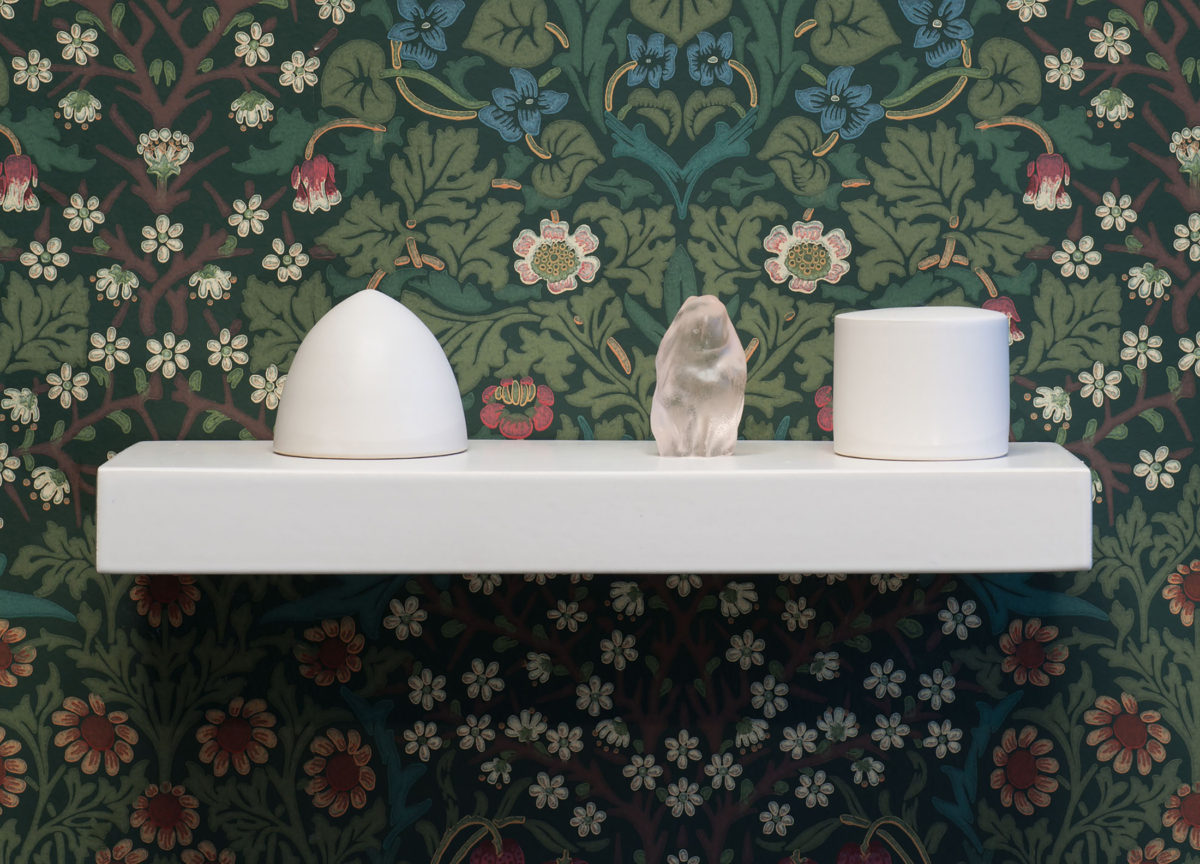And dusk turned dawn, Blackthorn
Shelley Selim
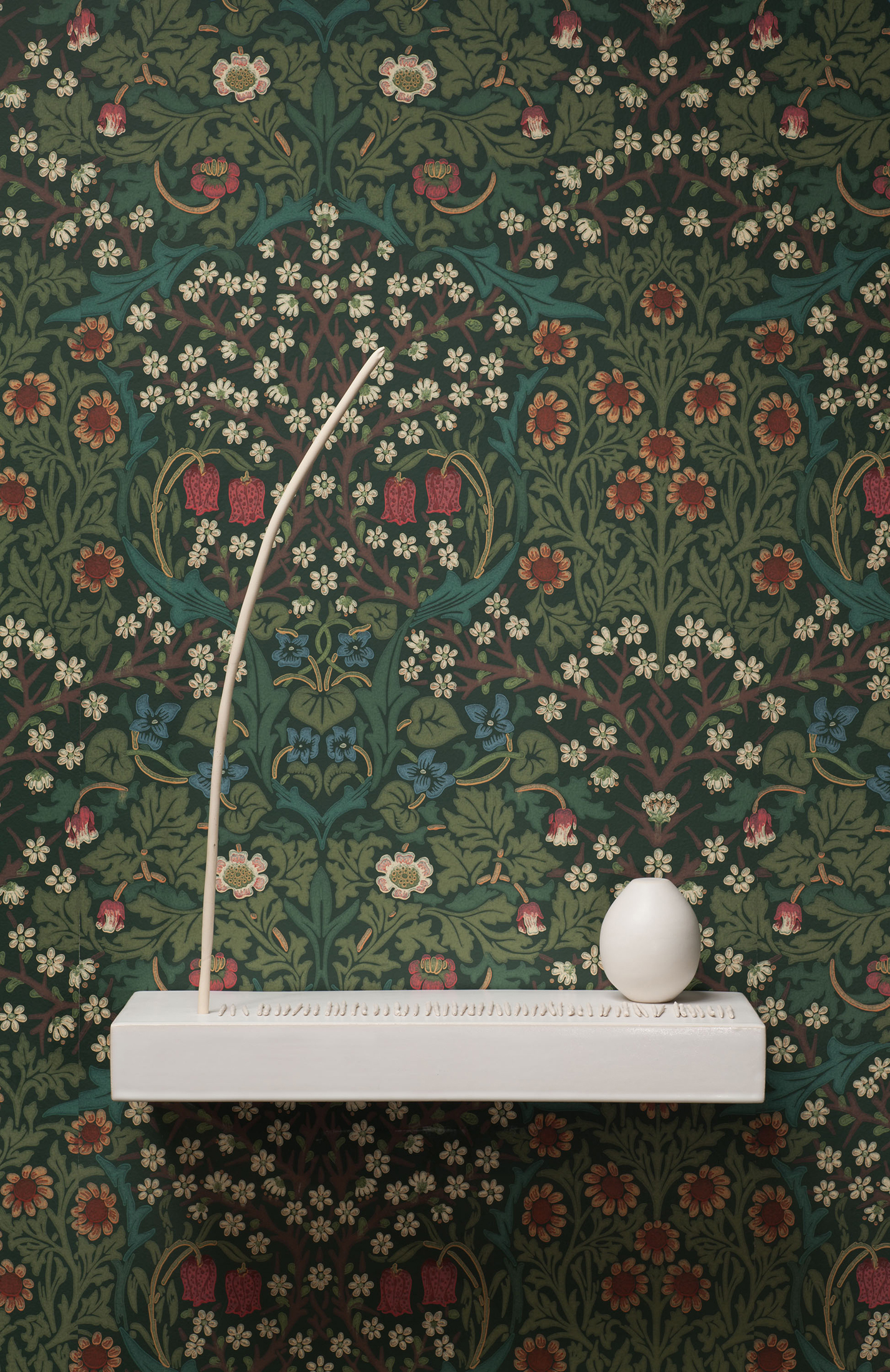
Wallpaper is a peculiar thing. Seemingly benign, it is both heralded and disdained for its unapologetically ornamental nature, a bold statement of taste while remaining a subordinate backdrop to the interior. More than most other forms of household decoration, it evokes deep and often polarizing responses, and in the centuries-old, storied history of wallcoverings, there is perhaps no wallpaper charged with more symbolic meaning than that created by the Arts and Crafts heavyweight William Morris.
In And dusk turned dawn, Blackthorn, her 2015 solo exhibition at the Simone DeSousa Gallery in Detroit, Marie Torbensdatter Hermann employs Morris & Co.’s iconic Blackthorn wallpaper, designed in 1892, as a stage for twelve wall-mounted ceramic, rubber, and resin tableaux, building a graceful floating topography that unfolds as a commentary on both personal and cultural identities. While Hermann’s ceramic sculptures frequently address the systems of the everyday, in this installation she delves into the rich historical ideologies behind those systems, how they manifest in nuance, and ultimately gain and lose denotative values within the realm of domestic consumption.
For Morris, wallpaper as it existed in the late-nineteenth century represented everything wrong with post-Industrial Revolution England: mass produced and machine printed, it robbed the factory worker of the joys of making by hand. So when he began designing it himself, he did so under the tenets of the Arts and Crafts movement that he pioneered, formulating block-printed repeats for each color to be hand-executed, thereby celebrating the felicities of individual, human expression. It was what Morris deemed a “glorious art, made by the people and for the people, as a happiness to the maker and the user.”1William Morris, “The Art of the People,” Hopes and Fears for Art (Boston: Roberts Brothers, 1882), 70. An ardent socialist, his wallpaper came to represent something far beyond mere decoration: it was a badge of glory for the gratification of labor, although ironically it was the master craftsmen of his studio, not Morris, who executed most of his designs.
Blackthorn is extracted from its Victorian context in Hermann’s installation, its symmetrical arabesques of blossoms, vines, and Common Hawthorn branches becoming instead a collective foil for austere, ghostly vignettes, poised on milky-white ceramic ledges that hover flush on its surface. Her forms in clay, thrown, turned, and pinched with gentle precision, wholly embody Morris’s consecration of the handmade. But against the reproduction wallpaper, which is still printed by Morris & Co., although now by machine, they immediately question the consequence of a century’s lapse. What was made once as a political statement is now commodified and vaguely extravagant, devoid of precisely the process that imbued it with (sub)cultural value. Hermann’s work, meanwhile — pristine, at times utterly Purist in stature — stands in abrupt formal contrast, yet perpetuates Morrisian dogma.
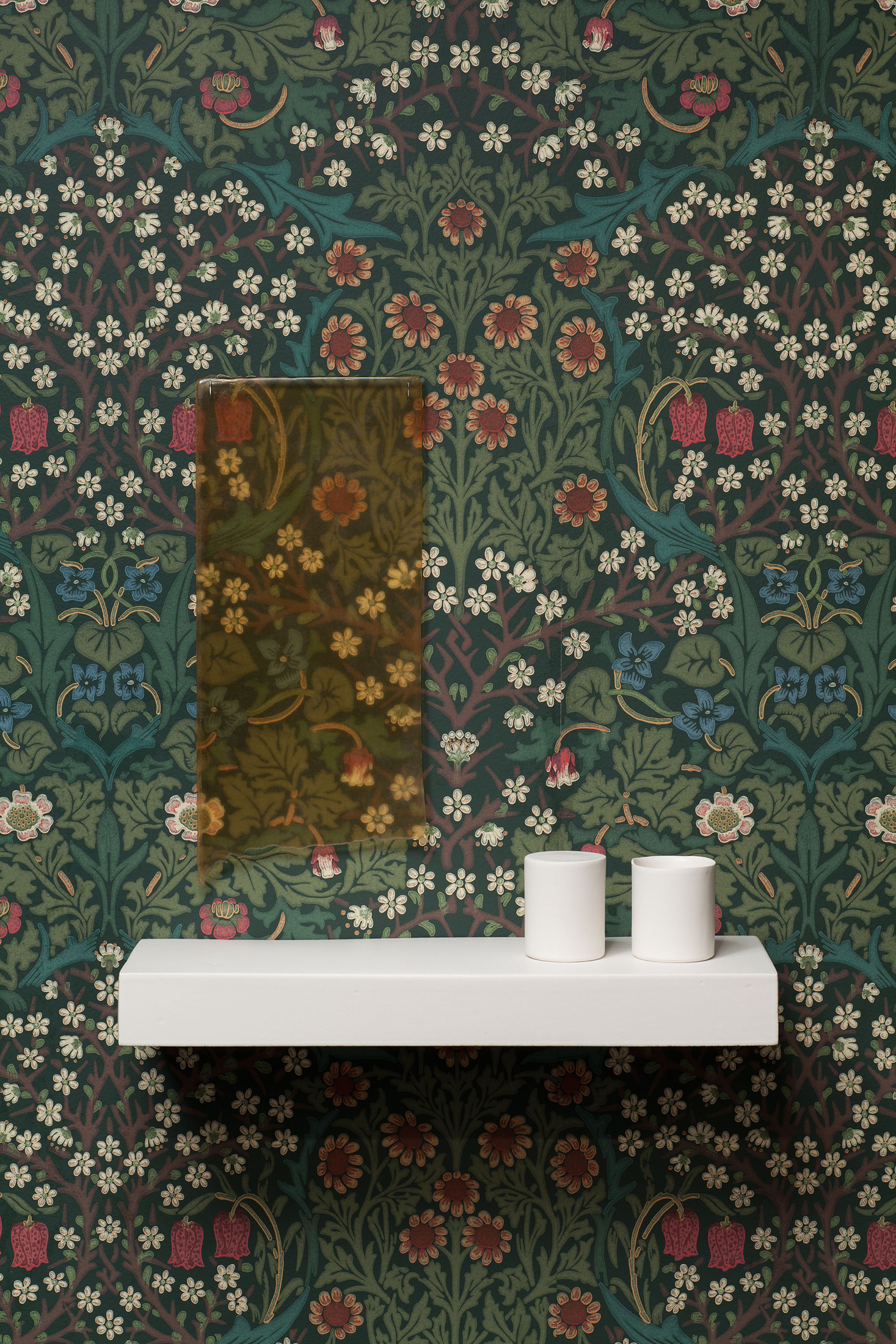
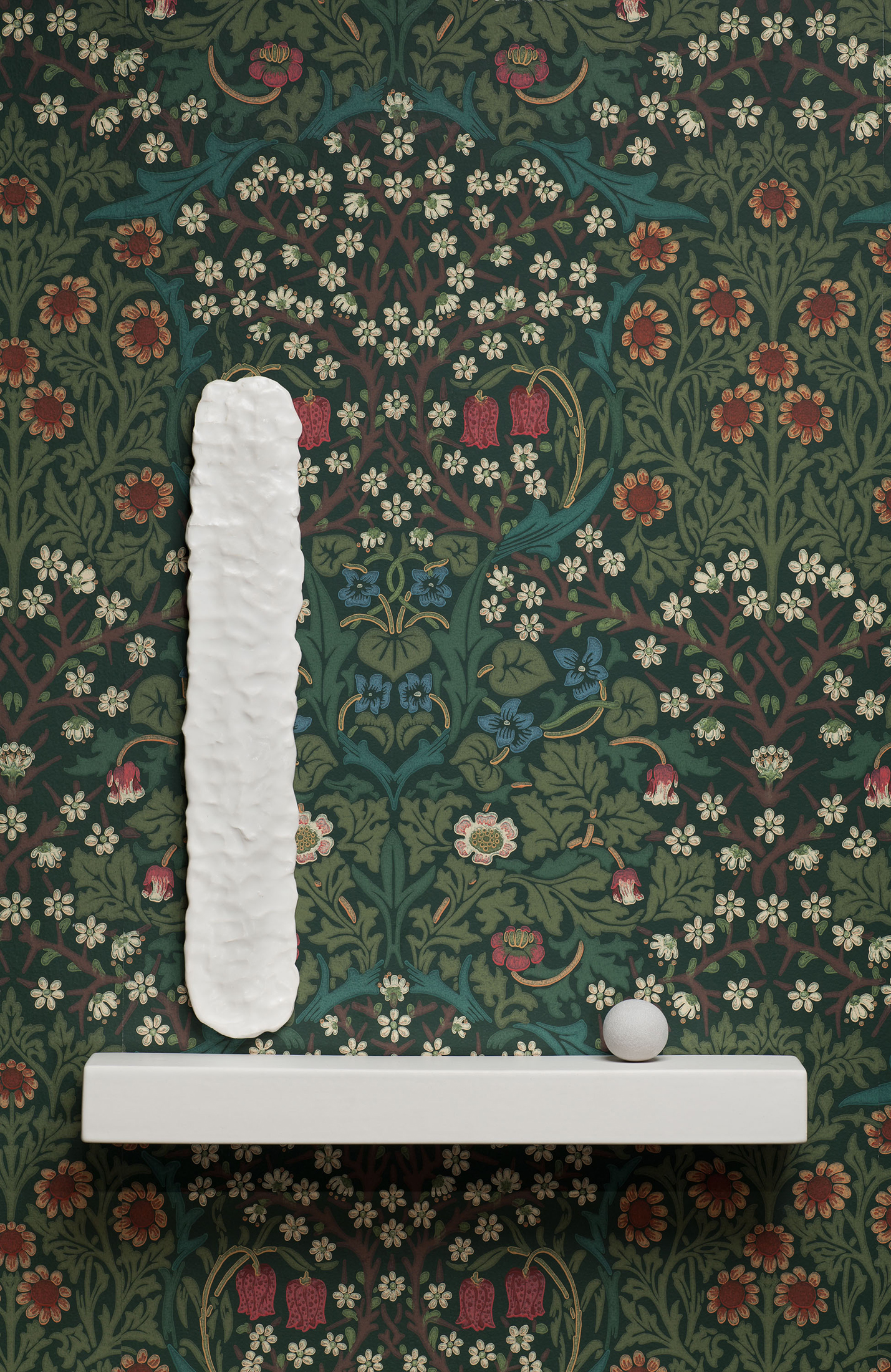

However this installation is not a testament to craft theory or artistic legacy, but instead addresses deeper subjective and sociopolitical meanings. Hermann was raised in Denmark by architects working and living under the sterile purview of Nordic modernism,2The complexity of the term “Nordic” or “Scandinavian” modernism is implied and should be acknowledged here. Cf. Kjetil Fallan, ed., … yet in a bold stylistic break they chose to wallpaper a guest room in their seventeenth-century vacation farmhouse with Morris’s Blackthorn. This staggering contrast of aesthetic became a source of wonder for Hermann throughout her life, and there is a subtle but important thematic connection present: Just as Morris’s socialist leanings informed his mission to restore dignity to the worker and consequently his philosophies on design, the democratic-socialist Nordic model cradled, bolstered, and canonized the “Scandinavian modern” design program in the mid-century. While visually dissimilar, they are manifestations of the same base ideological impulse — to transform societies and elevate the human condition through the built environment. Hermann’s canisters, discs, and domical wares — sober, stark, and meticulously proportioned — are informed by Danish modernism’s puritanical order and exaltation of the home, yet they wryly reject its mandate for purpose. Pots with no repository, dishes with no well, they are both dynamic impressions of a cultural imperative and luring, tactile mentions of the sentimental familiar. Teamed with more enigmatic forms — knobby, bulging bodies; sprouting pedicels; eerie, serpentine coils; and wilting latex — Hermann confounds the viewer by placing in apposition the recognizable and the surreal. Her sensitive object groupings recall the quiet ease of the everyday, challenging, as Rebecca Hart has noted, “our preconceptions about the world of things.”3Rebecca Hart, “Tocata (570),” in Marie Torbensdatter Hermann: A Gentle Blow to the Rock (Paris: Galerie Nec, 2012), reprinted in this journal. Like a displaced memory, they beg to be recognized but never fully incarnate.
Effectively the artist is pinpointing what she calls “systems of insignificance” — facets of living that hinge upon the habitual and the tacitly understood. She emphasizes the methodical—the repeat pattern of the wallpaper; the turn of a bowl on a wheel; the belabored roll of a wrapped thread — to celebrate and dramatize the mechanical nature of routine. The title — And dusk turned dawn — suggests the same. Whether a favorite mug, a towel rack, or a row of books, household objects in our lives create frameworks for customary systems that we take for granted, like the setting and rising of the sun. By robbing common objects of identifiable function, Hermann confronts us with the buried intrigue of the ordinary, much like Morris does (in a more conspicuous sense) by hallowing a pervasive shrub in his wallpaper patterning. We are left to consider the form and space and presence of things, and the meter of their arrangement. It is to some degree a psychology of the mundane. Ultimately, Hermann draws upon past design principles that prescribe a specific, ideal mode of living, and subverts them by highlighting the latent beauty of our present condition. While Morris and the modernists hoped to channel objects as tools to forge a brighter future, And dusk turned dawn, Blackthorn mines the character and cadence of the existing quotidian — the extraordinary ordinary now.
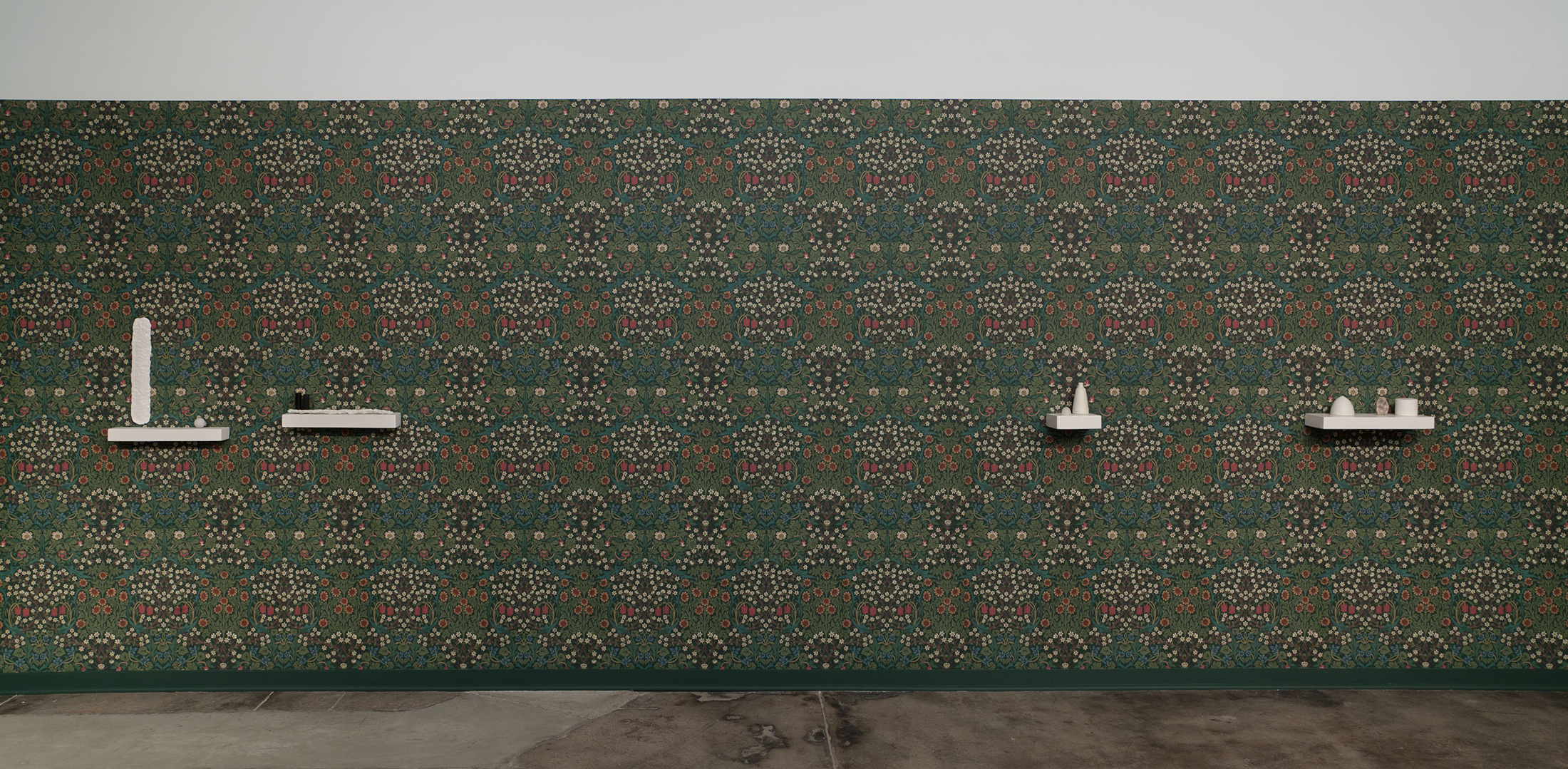
Installation details from Marie T. Hermann’s, And dusk turned dawn, Blackthorn, 2015, Simone DeSousa Gallery, Detroit. Photos by Tim Thayer
References
